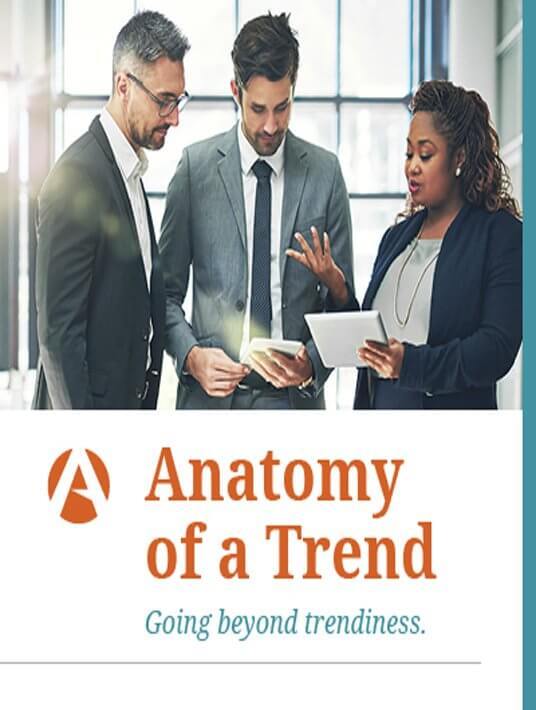Anatomy Of A Trend: Focusing On The Needs Of The Learner
New technologies are shifting the way people work: Microlearning gives just enough information to compel the right action for the moment; mobile learning makes it possible to treat your learners like customers and deliver them what they need, when they need it; and personalization allows to make your audience feel like their learning is custom-fit, not a mass-produced, one-size-fits-all training.

In the second part of this three-part article series about trends that are changing Learning and Development we will explore Augmented/Virtual Reality and gamification, whereas in the third part we will focus on the marketing-based approach to training.
Let’s begin with a trend that resembles a good marketing strategy: Microlearning.
1. Microlearning: Just Enough Learning
Honestly, microlearning is not a trend anymore; it has become a Learning and Development staple, but approaching the learning experience with a microlearning mindset can also enhance the delivery of other trends, which is why we include it here.
Prolonged training in one sitting on any topic was never that conducive to learner retention, but with most learners used to googling whatever they want to know as they need it, hours in front of a screen or in a class have become even less effective. Microlearning has become a staple because it forces Instructional Designers and developers to break down and re-structure what learners need to succeed, and it allows learners to get more meaning out of the experience as they gain control over what and when they learn.
How To Use Microlearning Most Effectively
The key here is to not equate micro with short. Sure, we are asking content to be condensed, but the driver behind that is focus; not time. Break down what learners need to do or think into distinct steps, give them time to practice, and consider how all the microlearning elements support each other. With this approach, you can even apply microlearning to improve your long-form content.
2. Mobile: Learning When It Matters
Mobile learning has been a trend primarily because it addresses a problem that has long been facing Learning and Development: How to provide just-in-time learning in the field? For any industry where learners aren’t tied to a desk, mobile learning provides contextual learning and performance support where a live-mentor or reference book just isn’t practical.
But don’t get comfortable if you aren’t in that kind of industry either. Cisco has predicted that by 2021 there will be seven times the amount of mobile data traffic than there is now. That means more people “will be using mobile phones (5.5 billion) than…running water (5.3 billion)”. While it’s difficult to know just exactly how that will impact workflow, it is clear that an overwhelming amount of learners will be using mobile devices, and having mobile ready training will allow them to learn anytime and anywhere.
How To Use Mobile Learning Most Effectively
Here’s where microlearning comes into play. Learners are not likely to spend an hour or more in one sitting on a mobile device – have you tried it? It’s not comfortable. But even with comfort aside, they are using a mobile device because they are on the go. They want something to the point so they can get back to work. If you want learners to use mobile learning, then it should also be microlearning.
3. Personalization: Learning Just For Me
The “What’s in it for me?” factor crosses over time and industry. Any good training will attempt to show its worth to learners, but personalization lets you skip building a carefully crafted argument on why your learner should sit through the training for the few parts that actually apply to them. Instead learners save time and mental space focusing on what impacts them, letting the relevance and meaningfulness speak for itself. We love any trend that makes learning more meaningful.
How To Use Personalization Most Effectively
Developing personalized learning experiences may seem daunting because it adds another layer of considerations. Or your stakeholders may be worried that learners miss out on important information. Fortunately, the amount of personalization in a learning experience is easily scalable. When considering personalization, separate what applies to all your learners and what can vary depending on the situation, the timing, the role, or the individual.
- Don’t have a lot of variance?
That’s okay; you can still use a simple personalization strategy to call out the most relevant information for learners and get their buy-in – for example, a short pre-assessment diagnostic. - Have a lot of variance?
Then personalization could be more than a nice touch; it could be the factor that takes the impact of your learning experiences to the next level. Consider a robust personalization strategy that assigns or allows learners to select microlearning modules to meet their learning needs.
If you want to know more about the latest Learning and Development trends, download the free eBook Anatomy Of A Trend – Going Beyond Trendiness now.
Related Articles
- Free eBook: Anatomy Of A Trend – Going Beyond Trendines
- Anatomy Of A Trend Part 2: AR/VR And Gamification
- Anatomy Of A Trend Part 3: Marketing-Based Approach To Training









